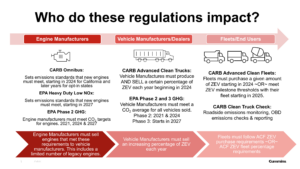impact, we will lay the groundwork for understanding the various regulations along with where and when they are in play for trucking fleets.
As we all navigate the energy transition, those of us at Cummins are committed to lead through both our innovative and regulatory expertise to encourage an empowered industry workforce.
To start out, let’s discuss what is being regulated. First there are criteria pollutants. Criteria pollutants or “tailpipe emissions” include particulate matter (PM) and nitrogen oxides (NOx).

regulating criteria pollutants with its Omnibus regulation that started this year. Next, there are greenhouse gases (GHG). Greenhouse gases trap heat in the Earth’s atmosphere which contributes to climate change. GHG is made up of six different gases including carbon dioxide (CO2) and nitrous oxide (N2O). EPA’s GHG Phase 2 and newly released Phase 3 regulations specifically address GHG. EPA’s Heavy–Duty Low NOx regulation was adopted in 2022. This nationwide rule sets stronger emissions standards for heavy–duty engines starting in model year 2027 with a 35mg NOx standard.
It requires that those emissions standards be met for a longer period of time while those engines are on the road including additional in–use testing protocols and lengthening the emissions warranty.
On the greenhouse gas side, EPA finalized its GHG Phase 2 regulation in 2016 with separate CO2 standards to be met by engines and vehicles in 2021, 2024 and 2027. Earlier this year, EPA finalized Phase 3 regulation with CO2 standards that need to be met at the vehicle level for model years 2027 through 2032. Phase 3 CO2 standards are up to a 60% reduction compared to Phase 2 standards. Phase 3 is technology-neutral, meaning each manufacturer gets to choose what technology to use to comply with the standards.
CARB finalized its Advanced Clean Trucks (ACT) rule in 2021. Advanced Clean Trucks took effect this year, regulating vehicle manufacturers that sell vehicles over 8,500 pounds GVWR in the state of California. ACT mandates that manufacturers sell a certain percentage of zero-emission vehicles (ZEV) each year with those percentages increasing each year until 2035. There is a second, less-talked-about portion of ACT called the Large Entity Reporting Requirement. This is a one-time fleet reporting requirement for entities with 50 or more vehicles under common ownership or control, or over $50 million revenue that operate a single vehicle over 8,500 pounds in California. States that are planning to adopt ACT over the next few years are Oregon, Massachusetts, Washington, New York, New Jersey, Vermont, Colorado, New Mexico, Rhode Island and Maryland. ACT has continued to evolve, as demonstrated by recent amendments approved by CARB that addressed issues that rose from the rule’s implementation. Those are deeper details for another day.
In 2023, CARB also adopted Advanced Clean Fleets (ACF) as companion regulation to ACT. Advanced Clean Fleets regulates fleets that operate vehicles in California. There are three different types of fleets that are regulated, each with different compliance pathways—high priority fleets are fleets that have at least 50 trucks or $50 million in revenue and drive at least one vehicle into California that is over 8,500 pounds GVWR, state and local government fleets in California, and drayage fleets that operate in California. A fleet’s compliance strategy depends on its fleet type. Drayage fleets can only add zero-emission vehicles to their fleets starting in 2024. State and local government fleets have a 50% ZEV purchase requirement starting in 2024 or they can opt into the High Priority and Federal Fleet Milestone Provision. High priority and federal fleets have two compliance pathways with the default being they can only add ZEV to their fleets starting in 2024. The second compliance pathway is the Milestone Provision that mandates fleets maintain a certain percentage of ZEV in their fleets. The final part of ACF is a 100% ZEV sales requirement that applies to vehicle manufacturers starting in 2036. The 100% ZEV sales requirement was just approved to be moved under the ACT regulation with the ACT amendment package approved by CARB last month.
Most fleets in the United States, if not all, will be impacted by at least one or more of these regulations in the coming years, if they are not already. Understanding how each of these regulations impacts fleets is an absolute must. Cummins Corner will dedicate a series of coverage, providing deep dives into each set of rules and how they impact the North American trucking industry.
Mari Mantle joined Cummins in 2011 and has held a variety of roles throughout the organization. She has spent time advising customers and small OEMs as an emissions compliance leader for the local Cummins Pacific region, overseen the Government Funding Program for low NOx repowers, managed several continuous improvement projects as a certified Six Sigma Black Belt, and spent time as an account executive managing the Northern California bus market. In her current role as Cummins’ regulatory affairs manager, Mantle collaborates with regulatory agencies, business partners and industry groups to implement Cummins’ Destination Zero vision. She is based in the San Francisco Bay Area and holds a bachelor’s degree in business administration from Cal State University-Hayward.







It looks like to me trucking companies would say enough is enough on this over regulated clean air garbage. The government is bankrupting trucking companies. Now trying to force electric trucks down our throats. Stand up against theses bureaucrats in Washington DC